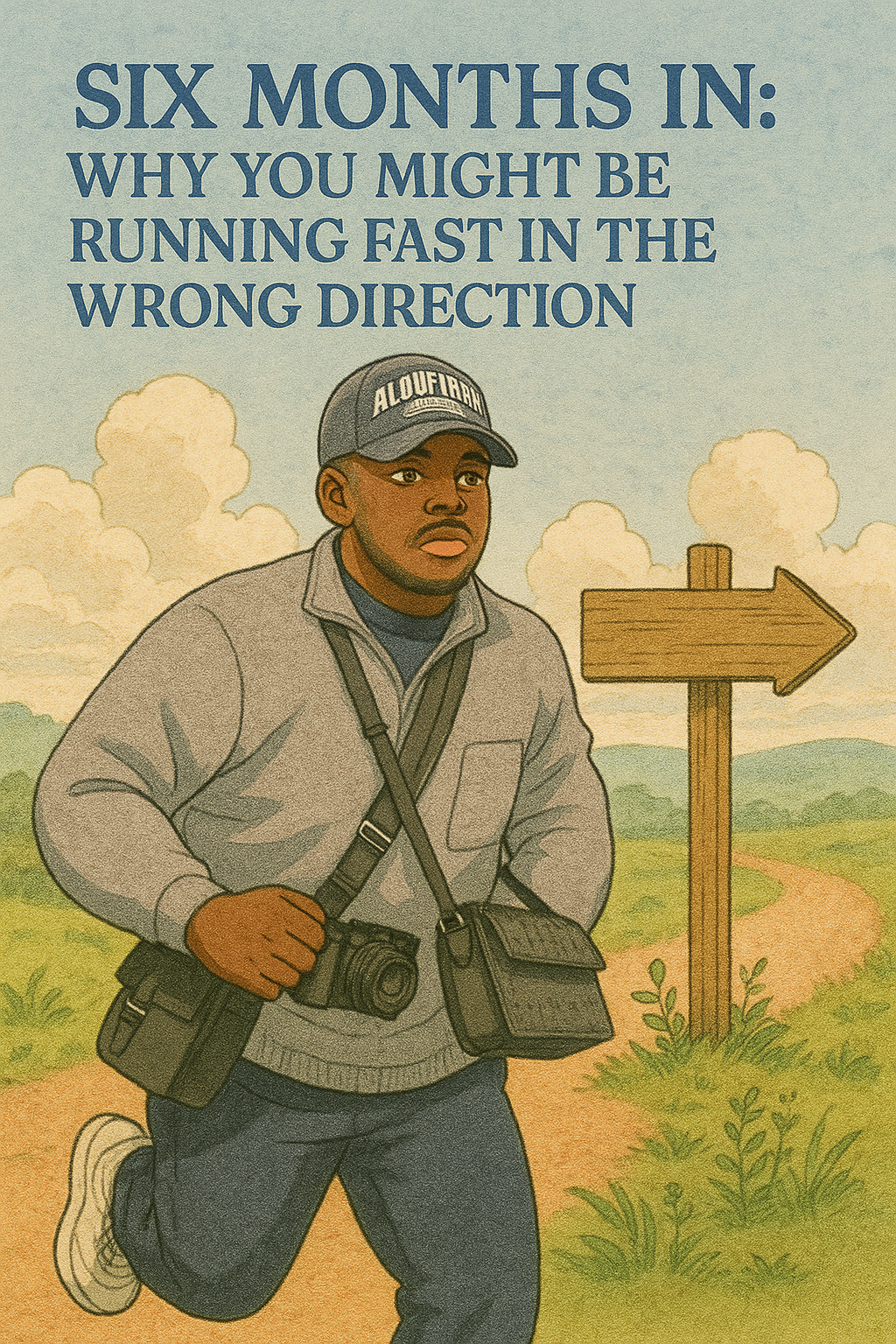
09 Jun Six months in: Why you might be running fast in the wrong direction
Good morning,
It’s mid-June. We’re at the halfway point in the year, and whether you’ve been grinding, drifting, or thriving, there’s one question I think we all need to ask right now:
Am I running in the right direction?
Not “am I busy?” or “am I making progress?”, but “am I actually working toward something I still believe in?”
Six months is a long enough time to drift, to forget and to pivot unconsciously. It’s also long enough to accumulate momentum in a direction that no longer feels honest. For many of us, especially those who are high-functioning and goal-oriented, the scariest thing isn’t being unproductive. It’s being productive at the wrong thing.
I want to use this newsletter to walk you through a mid-year reckoning: not a guilt trip, but a re-grounding. A reorientation of focus before we commit another six months to something that may no longer matter.
1. The danger of compounding misdirection
One of the most seductive things about being productive is the illusion of correctness. We tell ourselves: “If I’m busy, I must be doing something worthwhile.” But busyness, as Greg McKeown reminds us in Essentialism, is not the same as progress. In fact, busyness can mask a deeper misalignment if we don’t pause long enough to interrogate what we’re building.
Let me give a personal example. In March, I was heads-down on two projects I thought were critical. I had workflows, Notion dashboards, Gantt charts—the works. On paper, it looked like success. However, I realised, over a weekend away with a mentor, that I hadn’t asked myself why I was still working on either of them. The original “why” had changed. The clients’ needs had changed. But I hadn’t. I was clinging to sunk cost and the need to appear consistent. That’s not strategy, it’s inertia dressed up as discipline.
This is where compounding misdirection happens. Every hour you invest in the wrong thing trains your brain to believe that it must be right. This is known as the escalation of commitment, a well-documented cognitive bias in behavioural psychology. We double down on our past decisions to avoid the emotional discomfort of admitting we were wrong, even if we suspect we’ve outgrown the goal.
This is why a mid-year review isn’t just a productivity tactic—it’s a spiritual discipline. It’s a way of telling yourself: I’m willing to disrupt even good-looking progress if it’s leading me somewhere I no longer want to go.
Something to help you reflect:
-
What goals still feel honest?
-
What goals are now just habits?
-
What part of your weekly grind feels quietly meaningless?

2. The false comfort of clarity by default
Every January, people declare goals with conviction. However, conviction, I’ve learned, isn’t always rooted in clarity. Sometimes it’s just loudness. You repeat a goal often enough, and it starts to sound true. Now the truth is, sounding true isn’t the same as being true.
By June, the real test begins—not of willpower, but of alignment. The goal you picked six months ago might not fit anymore. That’s not failure. That’s growth.
James Clear, in Atomic Habits, talks about the danger of identity-based goal setting. When you tie your self-image too tightly to a goal (“I’m the kind of person who always launches a new product in Q3”), you lose flexibility. You keep pursuing it long after the underlying desire has shifted. Instead of clarity by design, you settle for clarity by default. You don’t review your value, you execute. Execution without evaluation is reckless, no matter how impressive it looks from the outside.
Here’s a simple analogy. If a ship’s navigation system is off by just one degree, it may not seem like a big deal. However, after hundreds of miles, even a tiny miscalculation can result in missing the destination entirely. Small assumptions, when left unchecked, eventually become massive divergences.
I once worked with a coaching client who built a seven-figure business over five years. When I asked her if she was still fulfilled by her work, she hesitated. “I don’t think I am,” she said. “But I’ve become so good at it, it feels irresponsible to stop.” That’s the problem with success: it can be convincing even when it’s hollow.
A mid-year moment is a chance to recalibrate
3. Progress without peace is still a problem
Let me say something that might sound strange in a productivity newsletter: some of us need to do less. Not because you’re lazy or confused, but because your version of progress is exhausting you. It’s burning up all your peace.
There is a kind of productivity that robs you of your presence. It’s fueled by anxiety, not vision. It’s efficient but joyless. You meet your deadlines but miss your life. I’ve lived this version. It’s impressive, but unsustainable.
The second quarter of this year pushed me into a rhythm that looked excellent from the outside: multiple projects, packed calendar, good press. However, I noticed I had no time to think. No space to dream, essentially, no margin. When there’s no margin, there’s no meaning. The truth is that meaning rarely shows up in motion. It reveals itself in stillness.
Dr. Sandra Dalton-Smith, in her research on rest, highlights seven types of rest we need—not just physical but also emotional, sensory, creative, and spiritual. High performers often assume physical rest is enough. But what many of us actually need mid-year is creative rest: time to reconnect with imagination, with silence, with long walks and unstructured mornings.
Rest isn’t the enemy of productivity. It is the source of sustainable performance. Burnout isn’t caused by doing too much. It’s caused by doing too much of what no longer nourishes you.
If your output is increasing but your peace is evaporating, it’s not growth. It’s erosion.
Ask yourself these questions before you take a look at the mid-year review i’m going to share with you.
-
Where has your drive outpaced your peace?
-
What would rest look like this season—not as escape, but as nourishment?
-
Are you creating space for the kind of reflection that leads to better decisions?
A Mid-Year Practice
If you’re reading this and feeling the urge to realign, here’s a simple structure for your own mid-year reckoning:
-
Pause. Block 60/90 minutes this week. No distractions. No meetings. Just you, your thoughts, and a notepad.
-
Review. Write down your major goals from January. Which ones still resonate? Which ones feel stale? Which ones were ego-driven or externally imposed?
-
Recommit or Release. Decide what you’re recommitting to with full focus. Let go of anything that no longer fits your values or vision.
-
Reset Rhythms. Look at your calendar. What needs to change? Where can you insert a rest? Where can you prune the excess?
-
Refocus. Set 1–2 key priorities for the next 90 days. Not 12. Not 7. Just enough to move with intention.
The next six months are not a continuation, they are a chance to begin again. But you don’t get that chance unless you choose it. Don’t let the momentum of the past rob you of clarity for the future.
This week, I hope you’ll choose to pause. Reflect. Realign. And if necessary, turn around. It’s better to change direction now than to arrive in December with a beautifully executed plan that leads to the wrong destination.
Have an amazing week!
M.T.
Elon and Trump’s Bromance Is Over?
What happens when two of the most powerful men in the world stop pretending to be friends?
Elon Musk and Donald Trump are at war. It started with EV mandates and a “Big Beautiful Bill,” but it’s escalated to accusations, threats of canceled contracts, and even Epstein file conspiracy theories. Yes — Musk claimed Trump is hiding in the unreleased Epstein documents.


